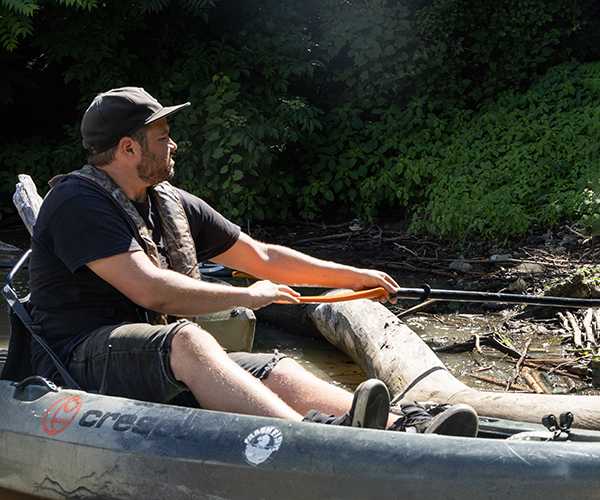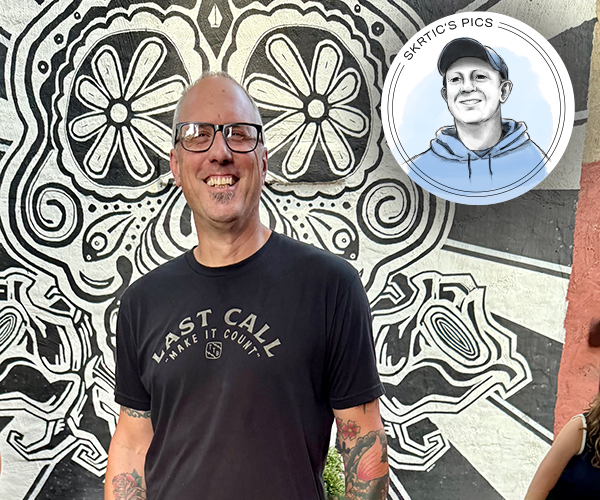Cleveland is about to change before our eyes. The visions of internationally renowned architects are about to become landmarks of our region. What it will take to build them begins with fund raising.
Fund-raisers’ names rarely appear on construction signs. Yet, if it weren’t for them, most buildings would never get built. They ask for money with flair, even panache. And right now, they’re raising big sums for our biggest names, such as The Cleveland Clinic and Cleveland Museum of Art.
The Clinic, the museum and other major area nonprofits are taking on ambitious expansion projects, funded by massive, eight- or nine-figure capital campaigns. With the region’s dismal economic climate, and many national and foreign donors preoccupied with natural disasters from the Gulf Coast to Pakistan, undertaking projects of this magnitude may seem like a big risk. Not so, say the folks in development. They’re succeeding and beating the trends thanks to a dedicated core of supporters, the allure of naming rights and exciting designs by big-name architects.
Cleveland Museum of Art has hired Rafael Viñoly Architects, masterminds of the famous Tokyo International Forum, Pittsburgh Convention Center and Museum of Modern Art in New York. Coop Himmelb(l)au, the Akron Art Museum’s “New School” Austrian architectural firm, lists the remodeling of the city of Vienna and city planning in Paris among its achievements. The Cleveland Clinic has employed NBBJ, a Seattle-based firm recently hailed by Architectural Record for “making waves” with the design of The Sail, a residential tower in Singapore. Its task here: designing a new $450 million medical complex anchored by a new heart center.
The Clinic has had no trouble raising funds for the new center. Its capital campaign has received more than $300 million in donations, putting it 18 months ahead of schedule. “We thought we could raise $200 million,” says Carol Moss, the Clinic’s vice chairperson for institutional development. “The administration thought we could raise $300 million.” Setting and meeting the higher goal hasn’t just helped build the heart center, it’s better for the Clinic’s overall financial health. After raising more money, the Clinic shows less debt, something especially important for its bond ratings.
Upon completion in 2008, the 1,000,000-square-foot heart center will include a 340-bed hospital, clinical space and a technology building. It’s expected to infuse an estimated $1.2 billion a year into the regional economy.
The Clinic is actually in the midst of two capital campaigns. The second is a $60 million effort to house the Glickman Urological Institute and other new initiatives. Fund-raising efforts began about two years ago when Cleveland businessman Carl D. Glickman and his wife, Babs, donated the lead gift of $8 million, earning them naming rights on the project. So far, the Clinic has raised more than $30 million for it.
Funding for the heart center has now entered its public phase. The center will include a new gateway to the Clinic, which will be called The Arnold and Sydell Miller Family Pavilion, thanks to a $70 million donation by Sydell Miller, co-founder of the hair and beauty products company Matrix Essentials, and her family. The state of Ohio contributed $5 million, the largest sum it has ever designated for a hospital project.
Moss says the Clinic has had no problem running two campaigns at once. That’s because the Clinic’s former patients are some of its biggest donors. “Patients are interested in funding their area of treatment,” she says. “Patients talk about giving back, so we’re actually approaching two different constituencies” — heart patients and urology patients.
Though Moss agrees that “raising money in today’s economy is more difficult for the fund-raising community in general,” she says it has had only a small effect on the Clinic’s search for funds. Much of its support comes from national and international donors, not from Cleveland. “After all, we have patients from around the world,” she says.
The Cleveland Institute of Music is also attracting donors worldwide. Having gained an international reputation, CIM finds that many of its international alumni are donating to the college’s capital campaign.
The school is constructing two new wings, a new façade and a state-of-the-art recital hall. CIM has already raised $33.5 million, or 88 percent, of its $40 million goal, says Susan M. Schwartz, the school’s director of marketing and communications. But the pressure is on: CIM received a challenge grant from the Kresge Foundation that promises $1.25 million if it reaches its goal by September 2006.
Schwartz says the school’s board of directors has led the way by raising more than $10 million for the capital campaign. Malachi Mixon III, chairman of the school’s board and also chairman and CEO of Invacare, donated $3 million along with his wife, Barbara, earning naming rights to Mixon Hall, the 250-seat recital hall that will be home to chamber music, solo recitals and student concerts. “He’s a great leader,” Schwartz says. “He not only leads with his skills, he also leads with dollars.”
In February, CIM will enter its public fund-raising phase. “We will dive in with a vengeance,” Schwartz says. “We hope to generate a couple of million in smaller gifts.”
The school is asking its supporters to contribute not only to the capital campaign, but also to the school’s annual fund. “This is a $1.3 million effort that helps pay for scholarships, free concerts, recitals and our faculty,” says Schwartz. “Ninety-seven percent of our students receive financial aid, so we need these dollars.” This year, CIM is trying a joint appeal, asking people to give to both the capital campaign and annual fund. “We believe this adds convenience, allowing our constituents to do all at once. We’ll see how it works out,” Schwartz says.
Across the street from CIM, Cleveland Museum of Art broke ground Oct. 1 on an expansion that will increase its size from 389,000 to 588,000 square feet and its gallery space from 89,000 square feet to 125,000. The price tag? An enormous $258 million.
The expansion will add two additions, an east wing and a west wing, and a large piazza with a soaring glass canopy at the center. Most of the museum’s galleries will be closed for the next two years during construction. Its permanent collection, now in storage, is tentatively set to reopen to the public in stages between 2007 and 2011. Meanwhile, the collection may tour internationally and nationally, stopping in Cleveland midway as a special exhibition.
Still, four to six years is a long time, so long that it’s led some to question whether the museum should have taken on such a large expansion.
But Jack Stinedurf, the museum’s director of development, says the ambitious $258 million plan was wiser than doing only part of the job. He estimates it would have cost about $150 million just to bring the four current buildings’ mechanics (heating and air conditioning, primarily) up to 21st-century standards and undertake some other small improvements. By pursuing the more ambitious project, the museum will increase its gallery space, create a larger restaurant and store, expand its parking garage by 150 spaces and construct an underground walkway connecting the garage to the building — all improvements he believes will benefit the museum for the next 50 years.
Unbeknownst to most of us, the museum’s expansion campaign began in 2002 with its silent and leadership phases. “We initially targeted very few prospects,” says Stinedurf.
“We have just begun identifying naming opportunities,” he adds. The museum will probably let major donors name the galleries but has not made a decision about naming the wings.
It seems that Donald Trump isn’t the only person who wants his name on a building. Look around town. Most new construction for any nonprofit organization carries the name of a large donor.
Many of these structures are attached to some prominent architect whose name brings prestige. Enter Rafael Viñoly Architects, the one that designed the Museum of Modern Art in New York. For the museum, like other institutions, a big architect on a project equals big bucks from donors, especially those after naming rights.
So how do development people go about asking for such large sums? “You put as much time in asking for thousands as millions,” Stinedurf says. “The strategy depends on the person and his or her affinity toward the organization and other factors.”
Stinedurf’s strategy is simple. “Start with those closest to the organization, both individuals and foundations.”
Yet after recent global disasters from the Asian tsunami to Hurricane Katrina to the Pakistani earthquake, many fund-raisers are discovering that philanthropic donations are scarce. “Human needs are definitely in the forefront,” Stinedurf acknowledges. “People’s minds are on that. Many believe that the arts are nonessential.”
So Stinedurf talks up the ways the museum benefits Cleveland and its economy. Fund-raisers aren’t just approaching their supporters for money, they’re also trying to attract state and federal money. How better to do so than to note that the project generates jobs?
The Akron Art Museum is also expanding. Currently housed in a historic 1899 post office, the museum is building a new wing. The two buildings will fit the museum’s focus on art from 1850 to the present; the artwork will mirror the old and new buildings’ ages.
The design of the extension by Coop Himmelb(l)au, the hot Austrian architecture firm, is raising eyebrows internationally. Its integration of steel, glass and site concrete contrasts starkly with the original, beaux-arts style brick post office building. Incredibly, the fragmented design of the expansion works well with the more traditional original structure, creating one powerful piece of architecture. “Coop Himmelb(l)au has a more European approach,” says Joan Lauck, the Akron Art Museum’s director of development. “They are accustomed to attaching a new building to an old and having them both function well independently and together.”
The price tag on this work of art, now under construction? $38 million. The museum’s capital campaign is almost there: It’s raised $35.4 million.
The campaign scored some early successes in 2000, when the museum received challenge grants from the John S. and James L. Knight Foundation, which promised $3 million if the museum raised $9 million, and the GAR Foundation, which pledged $6 million if the museum raised that much. The museum has since met both challenges. The Knight Foundation also made an outright $1 million gift for a permanent endowment for art education and outreach.
The museum has also received slightly more than $8 million from the state and some federal grants. Most other contributions have come from local donations.
Before embarking on the project, the museum did its homework. It determined exactly what it could gain by expanding through a fund-raising feasibility study, a needs assessment and strategic planning.
The museum was much too small, for starters. It has 3,300 pieces available in its permanent collection, yet it could only show 15 to 20 pieces at once in its 8,000 square feet of gallery space. Traveling exhibitions spilled into the permanent gallery. There was limited classroom space and no specific auditorium area for films and concerts.
So the expansion will triple the museum’s gallery space to about 25,000 square feet. And the city of Akron has donated an acre of property next to the building for future expansion.
“People can’t wait for it to open,” says Lauck. “They like the design.”
That should help the museum as it finishes its capital campaign. “We’re about to begin our public phase, and we’re anxious to get started,” she says.



